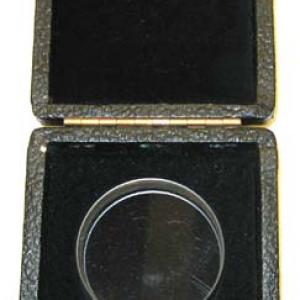College of Liberal Arts & Sciences
6D30.30 - Thin Film Interference - Air Wedges with Sodium Light
Plug the sodium lamp into the power supply and turn on. Allow about 5 minutes warm-up time. Adjust the screens in front of the lamp so that the light is directed onto the round plates directly in front of the lamp. Place one of the plates on top of the other. As the air is driven from between the two plates interference patterns are observed. Note that the pattern is not symmetrical due to irregularities of the plates or dust between the plates.
To observe a precise pattern you must use the optical flat.
There is a way to have large audiences view the inteference patterns if a video camera or projector is unavailable. Position the sodium lamp about 1 meter from a screen and pointing toward the screen. Pass out two microscope slides to each member of the audience. Put the two microscope slides together and look through them to view the sodium light on the screen. The interference patterns should be visible and can be changed by pressing the microscope slides together harder.
- Walter H. Kruschwitz, "Interference Bands Observable at a Distance From a Light Source", TPT, Vol. 44, # 4, Apr. 2006, p. 248.
- Brian Jones, "The Little Shop of Physics", TPT, Vol. 34, # 8, Nov. 1996, p. 514.
- G. R. Davies, "Interference and Diffraction Corridor Diffraction", TPT, Vol. 33, # 4, p. 244 - 247, April 1995.
- Zenon Gubanski, "Interference of Light Coming From an Air Wedge", TPT, Vol. 7, # 8, Nov. 1969, p. 455.
- Walter H. Kruschwitz, "Interference Bands Observable at a Distance from a Light Source", TPT, Vol. 13, # 5, May 1975, p. 296.
- C. R. Wheeler, P. N. Hendricksen, R. D. Ramsier, "Visibility of Thin-Film Interference Fringes", AJP, Vol. 72, # 2, Feb. 2004, p. 279.
- D. G. Sargood, "On the Use of Float Glass in Lecture Demonstration Experiments in Optics", AJP, Vol. 46, # 2, Feb. 1978, p. 187.
- Ol-15,18: Freier and Anderson, A Demonstration Handbook for Physics.
- O-455: "Air Wedge Between Glass", DICK and RAE Physics Demo Notebook.
- L-70: Richard Manliffe Sutton, Demonstration Experiments in Physics.
- "7.3: Interference and Diffraction", Cunningham and Herr, Hands-On Physics Activities, p. 467.
- "Bridge Light", The Magic Wand & Other Experiments in Light & Color, Exploratorium, p. 12-15.
- "Bright Light", Exploratorium Science Snackbook, 13-1.
- Raymond Bruman, "Bridge Light", Exploratorium Cookbook I, p. 9.1 - 9.2.
- W. Bolton, "Interference in Thin Films With Light", Book 2 - Waves and Particles, Physics Experiments and Projects, 1968, p. 23-24.
Disclaimer: These demonstrations are provided only for illustrative use by persons affiliated with The University of Iowa and only under the direction of a trained instructor or physicist. The University of Iowa is not responsible for demonstrations performed by those using their own equipment or who choose to use this reference material for their own purpose. The demonstrations included here are within the public domain and can be found in materials contained in libraries, bookstores, and through electronic sources. Performing all or any portion of any of these demonstrations, with or without revisions not depicted here entails inherent risks. These risks include, without limitation, bodily injury (and possibly death), including risks to health that may be temporary or permanent and that may exacerbate a pre-existing medical condition; and property loss or damage. Anyone performing any part of these demonstrations, even with revisions, knowingly and voluntarily assumes all risks associated with them.


